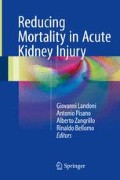Abstract
Renal replacement therapy (RRT) is the main supportive treatment for acute kidney injury (AKI). A meta-analysis suggested that “early” RRT could offer a survival advantage. However, there is no consensus about the criteria for optimal timing to start RRT in critically ill patients, as well as about what “early” exactly means. The cause of AKI is probably an important factor to be considered in deciding when to start the treatment: if RRT could help to treat the cause of AKI, as in sepsis or in acute respiratory distress syndrome, then an early initiation may be more useful than a late or “conventional” approach.
Access this chapter
Tax calculation will be finalised at checkout
Purchases are for personal use only
References
Seabra VF, Balk EF, Liangos E et al (2008) Timing of renal replacement therapy initiation in acute renal failure: a meta-analysis. Am J Kidney Dis 52:272–284
Conger JD (1975) A controlled evaluation of prophylactic dialysis in post-traumatic acute renal failure. J Trauma 15:1056–1063
Durmaz I, Yagdi T, Calkavur T et al (2003) Prophylactic dialysis in patients with renal dysfunction undergoing on-pump coronary artery bypass surgery. Ann Thorac Surg 75:859–864
Bouman CSC, Oudemans-Van Straaten HM, Tijssen JGP et al (2002) Effects of early high-volume continuous venovenous hemofiltration on survival and recovery of renal function in intensive care patients with acute renal failure: a prospective, randomized trial. Crit Care Med 30:2205–2211
Koo JR, Yoon JW, Oh JE et al (2006) Prospective evaluation of early continuous venovenous hemofiltration on the outcome in patients with severe sepsis or septic shock. J Am Soc Nephrol 17:50A (abstract)
Landoni G, Bove T, Székely A et al (2013) Reducing mortality in acute kidney injury patients: systematic review and international web-based survey. J Cardiothorac Vasc Anesth 27:1384–1398
Demirkiliç U, Kuralay E, Yenicesu M et al (2004) Timing of replacement therapy for acute renal failure after cardiac surgery. J Card Surg 19:17–20
Karvellas CJ, Farhat MR, Sajjad I et al (2011) A comparison of early versus late initiation of renal replacement therapy in critically ill patients with acute kidney injury: a systematic review and meta-analysis. Crit Care 15:R72
Han F, Sun R, Ni Y et al (2015) Early initiation of continuous renal replacement therapy improves clinical outcomes in patients with acute respiratory distress syndrome. Am J Med Sci 349:199–205
Shiao CC, Ko KJ, Wu VC et al (2012) U-curve association between timing of renal replacement therapy initiation and in-hospital mortality in postoperative acute kidney injury. PLoS ONE 7, e42952
Uchino S, Kellum JA, Bellomo R et al (2005) Acute renal failure in critically ill patients: a multinational, multicenter study. JAMA 294:813–818
Zarjou A, Agarwal A (2011) Sepsis and acute kidney injury. J Am Soc Nephrol 22:999–1006
Ronco C, Ricci Z, De Backer D et al (2015) Renal replacement therapy in acute kidney injury: controversy and consensus. Crit Care 19:146
Klein DJ, Foster D, Schorr CA et al (2014) The EUPHRATES trial (evaluating the use of polymyxin B hemoperfusion in a randomized controlled trial of adults treated for endotoxemia and septic shock): study protocol for a randomized controlled trial. Trials 15:218
National Heart, Lung, and Blood Institute Acute Respiratory Distress Syndrome (ARDS) Clinical Trials Network, Wiedemann HP, Wheeler AP, Bernard GR et al (2006) Comparison of two fluid-management strategies in acute lung injury. New Engl J Med 354:2564–2575
Jerng JS, Hsu YC, Wu HD et al (2007) Role of the renin-angiotensin system in ventilator-induced lung injury: an in vivo study in a rat model. Thorax 62:527–535
Terragni P, Maiolo G, Ranieri VM (2012) Role and potentials of low-flow CO(2) removal system in mechanical ventilation. Curr Opin Crit Care 18:93–98
Roberts DM, Roberts JA, Roberts MS et al (2012) Variability of antibiotic concentrations in critically ill patients receiving continuous renal replacement therapy: a multicentre pharmacokinetic study. Crit Care Med 40:1523–1528
Gonçalves-Pereira J, Póvoa P (2011) Antibiotics in critically ill patients: a systematic review of the pharmacokinetics of Β-lactams. Crit Care 15:R206
Joannidis M, Forni LG (2011) Clinical review: timing of renal replacement therapy. Crit Care 15:223
Bellomo R, Kellum JA, Ronco C (2012) Acute kidney injury. Lancet 380:756–766
Gibney RT, Noel SM, Bagshaw DJ, Johnston C (2008) When should renal replacement therapy for acute kidney injury be initiated and discontinued? Blood Purif 26:473–484
Barbar SD, Binquet C, Monchi M et al (2014) Impact on mortality of the timing of renal replacement therapy in patients with severe acute kidney injury in septic shock: the IDEAL-ICU study (initiation of dialysis early versus delayed in the intensive care unit): study protocol for a randomized controlled trial. Trials 15:270
Gaudry S, Hajage D, Schortgen F et al (2015) Comparison of two strategies for initiating renal replacement therapy in the intensive care unit: study protocol for a randomized controlled trial (AKIKI). Trials 16:170
Author information
Authors and Affiliations
Corresponding author
Editor information
Editors and Affiliations
Rights and permissions
Copyright information
© 2016 Springer International Publishing Switzerland
About this chapter
Cite this chapter
Monti, G., Greco, M., Cabrini, L. (2016). May an “Early” Renal Replacement Therapy Improve Survival?. In: Landoni, G., Pisano, A., Zangrillo, A., Bellomo, R. (eds) Reducing Mortality in Acute Kidney Injury. Springer, Cham. https://doi.org/10.1007/978-3-319-33429-5_5
Download citation
DOI: https://doi.org/10.1007/978-3-319-33429-5_5
Published:
Publisher Name: Springer, Cham
Print ISBN: 978-3-319-33427-1
Online ISBN: 978-3-319-33429-5
eBook Packages: MedicineMedicine (R0)

